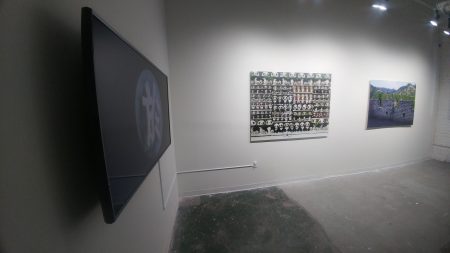What is God? A Westernized ideal, for one, in the monotheistic sense. But, God can also be interpreted as an energy or a sustaining force. God is universal truth, the unpredictability and breadth of the natural world, the ability of the cosmos to function — the cycles of life and death, themselves.
China, like many countries, has taken on a Godlike role in the world. Within its borders, it has assumed the role of God through radiant artificial light, omnipresent cameras, and the calculated labor of its people. Outside of its borders, China is the producer which keeps the shelves and bellies of most of the world full. The contemporary Chinese artists displayed in “Replace With Fine Art” are reckoning with the power of their home country, the treatment of their brethren, and the sacrifices of modernity.
The gallery showcases the work of four artists, working in photography and videography: Chen Qiulin, Chen Wei, Liu Bolin, and Jen Liu.
Upon entering the gallery, you are presented with Qiulin’s video “Color Lines” which depicts figures amidst flowing, lined silks and blankets, conjuring up a feeling of national recognition for a country’s flag that is not specifically named.
Next to the looping video, Wei’s photograph “Today is Unsuitable for Shooting” is displayed. A simple gaslit lamp stands alone in the night, giving off a glowing light. Light — what sustains almost everything on the surface of the planet. Light — possibly the simplest metaphor for God and sustenance. In this piece and the photograph “Future and Modern,” Wei captures the modern ways we mimic and mirror God through gaslights and LED billboards. We keep the light around of our own volition, even after the sun has set. It acts as a guide for some, as a commercial for others. A commentary of how God’s will may be construed in many ways by man. “Today is Unsuitable for Shooting” goes a step further, depicting 360° street cameras, which allow the state to have an omnipresent eye over its people.
Although these captured evocations of God’s energy clearly have a bite of criticism to them, the artist still appears to acknowledge the eery and surreal beauty of the inventions humans brought into the world in order to play God.
Ren Hang’s striking figural photographs take a more positive spin, bringing the quintessential Chinese body back to nature. The pieces are reminiscent in style to some of Gucci’s more recent advertising campaigns, but without the clothes: crisp, lo-fi images of models caught in candid postures. The stark nudity of the models, amidst rich greens and blues of cacti and the ocean create a mythic connotation around the models’ forms. The figures are the godhead within the Chinese body, alight and active within a majestic natural playground which is too often lost amidst expensive skyrises and smog.
Qiulin’s video “1000 Surnames in Tofu” feels like yet another critique of a social creation which brings us further from universal truth. Watching on, viewers will observe depictions of surnames (a human construct) created with a man-made meat substitute, sizzling and being destroyed. This dissolution of surnames could represent the dissolution of the ego and the acknowledgement that the things we tell ourselves are true are often merely societal constructs.
Many of the contemporary Chinese artists displayed seem to be dealing with the fact that their nation is a powerhouse of production, often without regard for the people doing the producing. Liu’s video “The Pink Detachment,” for example, is a mash-up of stylized scenes revolving around meat processing. And Bolin’s “Hiding in the City” series of photographs tackle the subject of the many human lives which go into sustaining our modern-day consumerism. “Hiding in the City: Panda” depicts a wall of plush Panda bears and “Hiding in the City: Puffed Food” depicts a wall of brightly colored snacks. It is only when you step closer to these images that you notice the ghost of a human standing among the isles, perfectly painted to blend into the consumerist nirvana. A third image of Bolin’s, “Hiding in the City: Great Wall,” assumes the same style. This photograph, along with the two depicting more modern settings, show that humans have always sacrificed the lives and labor of their own for often futile and boring outcomes.
Together, these artists depict God-China as a rival to the God residing over the breadth of nature. One who is defining its own set of universal truths, possibly to the detriment of the humans who inadvertently worship it through being a part of its population. The works here ask viewers to reconsider what they let their countries (the closest entities we truly have to Gods) do with their bodies and their identities. Just maybe, we should forego duties to country and government, and rediscover ourselves naked in the wilderness like the figures in Hang’s photographs.
Art Academy of Cincinnati, Pearlman Gallery, Sept. 18-Nov. 2, 1212 Jackson St, (513) 562-6262
–Russell Hausfeld






